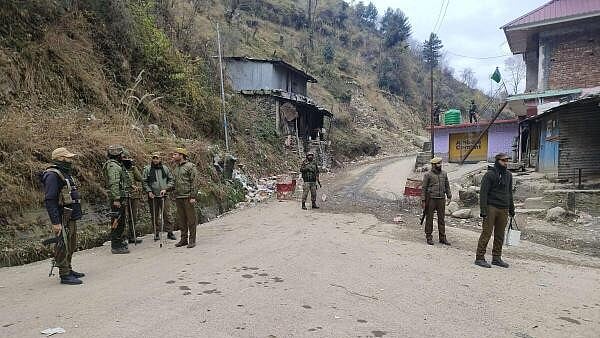
Army personnel during a cordon and search operation after the recent ambush on two Army vehicles that left five soldiers dead, in Poonch, Jammu and Kashmir. Representative image.
Credits: PTI File Photo
Geopolitical events — be it wars, terror attacks, or border conflicts — often dominate news cycles and trigger immediate reactions from investors. Panic selling, volatility spikes, and emotional decision-making are common. But as history shows, the real impact on the Indian stock market is often far less dramatic than the headlines suggest.
So, how much do these events actually move the market? And what happens after the initial reaction fades?
It’s the uncertainty, not the event
Markets don’t fear events as much as they fear uncertainty. The recent Pahalgam terror attack and India’s subsequent military response offer a clear example.
On April 23, right after the attack, the India VIX — a measure of market volatility — rose sharply from a low of 12.84 to 16.51. Over the next few days, even before any official military retaliation, it kept climbing, touching 19.30 on May 6, the night of Operation Sindoor. By May 9, the day before the ceasefire, VIX had surged 76 per cent from its April 23 low.
This means that more than half of the total volatility spike occurred before any concrete response, showing how markets react more strongly to fear of the unknown than to actual developments.
During this period, the Nifty struggled to find direction. But once the ceasefire was confirmed, the index quickly gained momentum and crossed the 25,000 mark by May 14. This pattern is consistent: volatility spikes during uncertain times, but once clarity emerges, markets stabilise and often rally.
Historical evidence: A pattern of resilience
The Indian market has faced multiple geopolitical tensions over the past two decades. Here’s a snapshot of how it has responded:
Kargil war (1999): The Sensex rose significantly during the war and delivered a strong return of around 28 per cent over the following year.
India-Pakistan standoff (2001–02): The market saw a mild decline of about 3 per cent, followed by mixed performance. One year later, it was nearly flat.
Mumbai attacks (2008): The Sensex dipped by 2 per cent but quickly rebounded, gaining over 90 per cent in the next 12 months.
‘Surgical’ strikes (2016): Despite initial volatility, the Sensex rose 26 per cent over six months and continued to grow steadily over the year.
Pulwama attack (2019): The market remained stable, with a moderate 6 per cent rise during the conflict and a 15 per cent gain over the year.
Galwan Valley clash (2020): The Sensex dipped the next trading day but recovered quickly, gaining 14 per cent within a month and nearly 67 per cent over the next year.
India-Pakistan skirmishes (2021): The market rallied from around 46,961 to 51,039, and ended with a strong 27 per cent gain after a year.
Pahalgam terror attack (2025): The Sensex dropped less than 1 per cent post-attack but rebounded by 3.74 per cent in a single day following the ceasefire announcement on May 12.
Across these incidents, one pattern stands out: short-term volatility is almost always followed by recovery and growth.
What this means for investors
For long-term investors, the takeaway is clear — avoid reacting emotionally to geopolitical headlines. Historical data shows that markets often absorb the initial shock and return to growth once the dust settles.
For instance, an investor who stayed invested during the India-Pakistan border skirmishes in November 2020, when the Sensex was around 46,961, would have seen a gain of nearly 76 per cent by May 14, 2025, as the index reached 82,530. Panicking and exiting early could have severely limited those returns.
Here’s what investors should keep in mind during such times:
Don’t make decisions based on fear or headlines.
Stay focused on long-term goals.
Use volatility as an opportunity to accumulate quality stocks.
Diversify across sectors to manage short-term risk.
Final thoughts
Geopolitical tensions may dominate headlines, but they rarely derail the long-term trajectory of the Indian equity market. From Kargil to Pulwama and now Pahalgam, the market has repeatedly demonstrated its resilience.
Even globally, while equity markets may drop 3–7 per cent during major conflicts, Indian markets often experience smaller, short-lived corrections. What truly drives market performance is economic growth, corporate earnings, and investor sentiment — not temporary conflicts.
In the end, it’s not the headlines that shape market outcomes. It’s discipline, data, and perspective.
(The author is Vice President- Research, Teji Mandi)